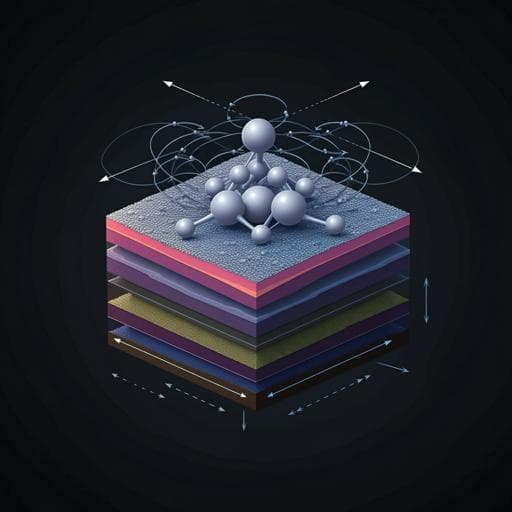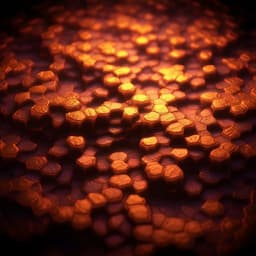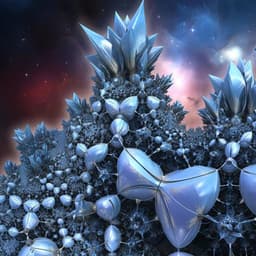
Engineering and Technology
Defect-gradient-induced Rashba effect in van der Waals PtSe₂ layers
J. Jo, J. H. Kim, et al.
This groundbreaking research by Junhyeon Jo, Jung Hwa Kim, Choong H. Kim, and their colleagues unveils the creation of a defect gradient and the Rashba effect in 1T-phase PtSe₂ thin films through plasma treatment. Scanning transmission electron microscopy reveals a unique defect structure, paving the way for advanced electronic applications.
~3 min • Beginner • English
Introduction
The study investigates whether an intentional defect-gradient in layered PtSe2 can break inversion symmetry and induce a Rashba spin–orbit interaction in a nonmagnetic, van der Waals material. Context: Defect engineering—traditionally via uniform doping—has been vital in semiconductors; in 2D materials, selective plasma treatments can create defects in a layer-dependent manner. Breaking time-reversal symmetry via magnetism has been pursued, but breaking inversion symmetry to realize Rashba coupling offers an alternative spin source. Theory predicts that organized or gradient-like defect distributions in 2D systems can produce inversion symmetry breaking and Rashba effects, yet experimental realization of periodic distributions is challenging. Purpose: Develop a controllable method to create a layer-by-layer defect gradient in PtSe2 using plasma etching and test for Rashba-induced nonreciprocal charge transport. Importance: Demonstrating a robust, room-temperature Rashba effect via scalable defect engineering could enable electrically controlled spin–orbitronic devices without ferromagnets.
Literature Review
Prior work established that plasma and post-growth treatments can engineer defects in 2D TMDs, affecting phase transitions, carrier concentration/type, and device performance (Refs. 1–9, 19). Defect-induced magnetism has been observed and predicted in 2D materials including graphene and TMDs (Refs. 11–16). Theoretical studies proposed that inversion symmetry breaking in 2D materials can be triggered by organized defect distributions or halogen doping in PtSe2, leading to strong spin–orbit effects and Rashba splitting (Refs. 17, 18). Nonreciprocal transport is a hallmark of non-centrosymmetric systems with Rashba interaction and has been observed in polar semiconductors, oxide interfaces, chiral conductors, and bulk Rashba semiconductors (Refs. 25–32). However, experimentally achieving a periodic defect superstructure is difficult, motivating the use of depth-dependent defect gradients to break inversion symmetry.
Methodology
- Materials and plasma treatment: PtSe2 thin films were mechanically exfoliated from bulk crystals (HQ Graphene) onto substrates (p-Si/SiO2, sapphire, or TEM grids). Reactive ion etching with mixed Ar and SF6 gases (equal ratio, up to 100 sccm total flow) was applied to create defects selectively (Ar preferentially etches Se; SF6 reacts with Pt). Etch rate was ~0.03 nm/s. Initial flakes (20–30 nm) were chosen so that after etching, the final thickness remained at least 7 nm smaller to accommodate a ~7 nm defect-gradient from the surface. AFM verified thickness/roughness before/after etching. XPS characterized Pt and Se oxidation states.
- Structural/chemical analysis: Cross-sectional STEM specimens were prepared by FIB with protective carbon coating. Atomic-resolution HAADF-STEM (FEI Titan Cubed G2 60–300, 200 keV, 26.6 mrad convergence, ~60 pA probe) was used. Elemental depth profiling was done by EDS (Super-X) and EELS (Gatan Quantum 965 dual EELS; 1.0 eV energy resolution, 0.1 eV/channel). Dual EELS captured zero-loss and core-loss to correct energy drift.
- Magneto-transport: Long, narrow PtSe2 flakes (<3 μm width) were fabricated into four-probe devices using photolithography and Ti(5 nm)/Au(40 nm) contacts in UHV. Measurements were performed in a PPMS with in-plane field rotation capability. DC measurements used a Keithley 2636A and 2182; AC second-harmonic measurements used a Keithley 6221 (10 Hz) and SR830 lock-in. Temperature-dependent resistance (Rxx), Hall effect (carrier density), MR with perpendicular fields (Bz), nonreciprocal MR under in-plane fields (By), and angle-dependent MR (ADMR) were measured for different thicknesses (10–15 nm). Nonreciprocal characteristics were probed with DC I=±500 μA and AC second-harmonic R2ω detection.
- First-principles calculations: DFT within LDA including fully relativistic SOC was performed using VASP (500 eV plane-wave cutoff; 7×7×1 k-point mesh). A 10-layer PtSe2 slab with 20 Å vacuum modeled the film. The virtual crystal approximation represented a vertical gradient of Se vacancies confined to the top 5 layers, linearly decreasing from the surface to the sixth layer, consistent with STEM-derived Se/Pt ratios. In-plane lattice constants were fixed to experimental values; internal positions were relaxed to forces <5 meV/Å with interlayer spacings constrained to experimental values for stability. Band structures were analyzed, and Rashba coefficients were extracted. The Se/Pt character of Bloch states was evaluated via projections onto atomic orbitals to correlate bands with defective vs pristine regions.
Key Findings
- STEM/EDS/EELS evidence of defect gradient: Cross-sectional HAADF-STEM showed a decomposed/crystallinity-perturbed near-surface region. EDS depth profiles revealed a Se/Pt atomic ratio decreasing from ~2.0 in the bulk-like region to ~1.1 near the surface, with a finite defect depth of ~7 nm. EELS confirmed reduced Se M4,5 intensity relative to Pt N6,7 near the surface and a ~0.4 eV red shift of Pt N6,7 with increasing dominance of N6 (~76 eV) over N7 (~73 eV), consistent with changes in Pt oxidation state and DOS.
- XPS: Plasma treatment altered Pt4+ toward Pt2+ and metallic Pt states, corroborating Se vacancy formation and local chemical environment changes versus pristine PtSe2 (Pt4+, Se2−).
- Transport signatures of plasma-induced defects: Plasma treatment strongly reduced RRR; pristine films had RRR > 3, while plasma-treated films reached as low as 1.30. The effect weakened with increasing thickness due to finite defect depth. Carrier density at 2 K dropped from 3.2×10^21 cm−3 (pristine, 10 nm) to 3.6×10^20 cm−3 (plasma-treated, 10 nm). Ordinary MR under perpendicular fields decreased markedly in treated samples, consistent with lower mobility in defective films, with stronger suppression for thinner films.
- Nonreciprocal transport (Rashba effect): Pronounced directional MR was observed under in-plane magnetic fields for plasma-treated films (e.g., 10 nm) with I=±500 μA. ΔMR was linear in magnetic field magnitude. The nonreciprocal coefficient γ ≈ 5×10^−2 A^−1 T^−1, comparable to known Rashba/polar systems. Pristine films showed no nonreciprocity. Angle-dependent MR exhibited asymmetry between +y (θ=0°) and −y (θ=180°) that inverted with current direction, fitting a model including a current-induced Rashba field BR. The effective Rashba field was estimated as BR ≈ 4.81 T at I=+500 μA and B=+8 T, scaling linearly with current. Nonreciprocal MR persisted up to 300 K. The magnitude decreased with increasing film thickness (10→15 nm), consistent with a finite defect depth; below ~8 nm thickness, PtSe2 becomes semiconducting and nonreciprocal MR diminished with further thinning.
- Second-harmonic detection: R2ω showed sin^2θ angular dependence with maxima at ±y, inverted upon reversing B, and scaled linearly with the y-component of B and with current, confirming magnetochiral/nonreciprocal transport.
- DFT confirmation: A slab with a top-layer Se-vacancy gradient produced large Rashba-type spin splitting for bands localized in the defective region when SOC was included, while bands from pristine layers remained spin-degenerate. The Rashba coefficient at the Fermi level was ~2.2 eV·Å along Γ–K, comparable to giant Rashba materials (e.g., BiTeI ~3.8 eV·Å). Both SOC and inversion breaking from the defect gradient were necessary for the splitting.
Discussion
The results directly address the hypothesis that a controlled vertical defect gradient in PtSe2 breaks inversion symmetry and induces Rashba spin–orbit coupling. Structural and spectroscopic analyses established a ~7 nm gradient of Se vacancies from the surface, corroborated by shifts in Pt EELS features and XPS. Transport measurements revealed hallmark signatures of Rashba systems—nonreciprocal MR and angle-dependent asymmetries—that scale linearly with magnetic field and current, and yield a sizable current-induced effective Rashba field. The persistence of nonreciprocal transport to room temperature underscores the robustness of the induced Rashba interaction. Thickness-dependent trends (diminished effect with thicker films due to finite gradient depth; reduced signal in very thin, semiconducting regime) are consistent with the proposed mechanism. DFT calculations reproduce large Rashba splitting only in the vacancy-gradient region and quantify the Rashba coefficient, establishing that inversion breaking from the engineered defect profile is the essential ingredient alongside SOC. Collectively, the findings validate defect-gradient engineering as a viable route to imprint Rashba physics into van der Waals materials for spin–orbitronics without magnetic layers.
Conclusion
This work demonstrates a facile, selective plasma treatment to create a vertical defect gradient in layered PtSe2, breaking inversion symmetry and producing a robust Rashba effect. Atomic-resolution STEM/EDS/EELS show a Se-vacancy gradient extending ~7 nm from the surface with Se/Pt decreasing to ~1.1. Transport reveals strong, room-temperature-persistent nonreciprocal MR with a sizeable current-induced effective Rashba field and a nonreciprocal coefficient comparable to known Rashba systems. First-principles calculations confirm large Rashba splitting (α_R ~2.2 eV·Å) localized to the defective region, requiring both SOC and inversion breaking. These results establish defect-gradient engineering as a practical platform to enable spin–momentum coupling in 2D materials. Future directions include optimizing gradient depth and profile, extending the approach to other TMDs and van der Waals systems, integrating into device architectures for spin–orbit torque or rectification functionalities, and exploring electric-field control of the Rashba effect.
Limitations
- Finite defect depth (~7 nm) limits the effective volume fraction contributing to Rashba effects; consequently, the nonreciprocal signal decreases with increasing total film thickness.
- For very thin films (<~8 nm), a thickness-driven metal-to-semiconductor transition complicates transport and reduces the nonreciprocal MR, narrowing the optimal thickness window.
- Plasma treatment introduces disorder that reduces mobility (lower MR, lower RRR) and alters oxidation states, which may impact device performance and make it challenging to decouple Rashba effects from general defect-induced scattering.
- The engineered asymmetry is a gradient rather than a periodic defect superstructure; fine control over the precise depth profile may be limited by plasma process parameters and material variability.
Related Publications
Explore these studies to deepen your understanding of the subject.







